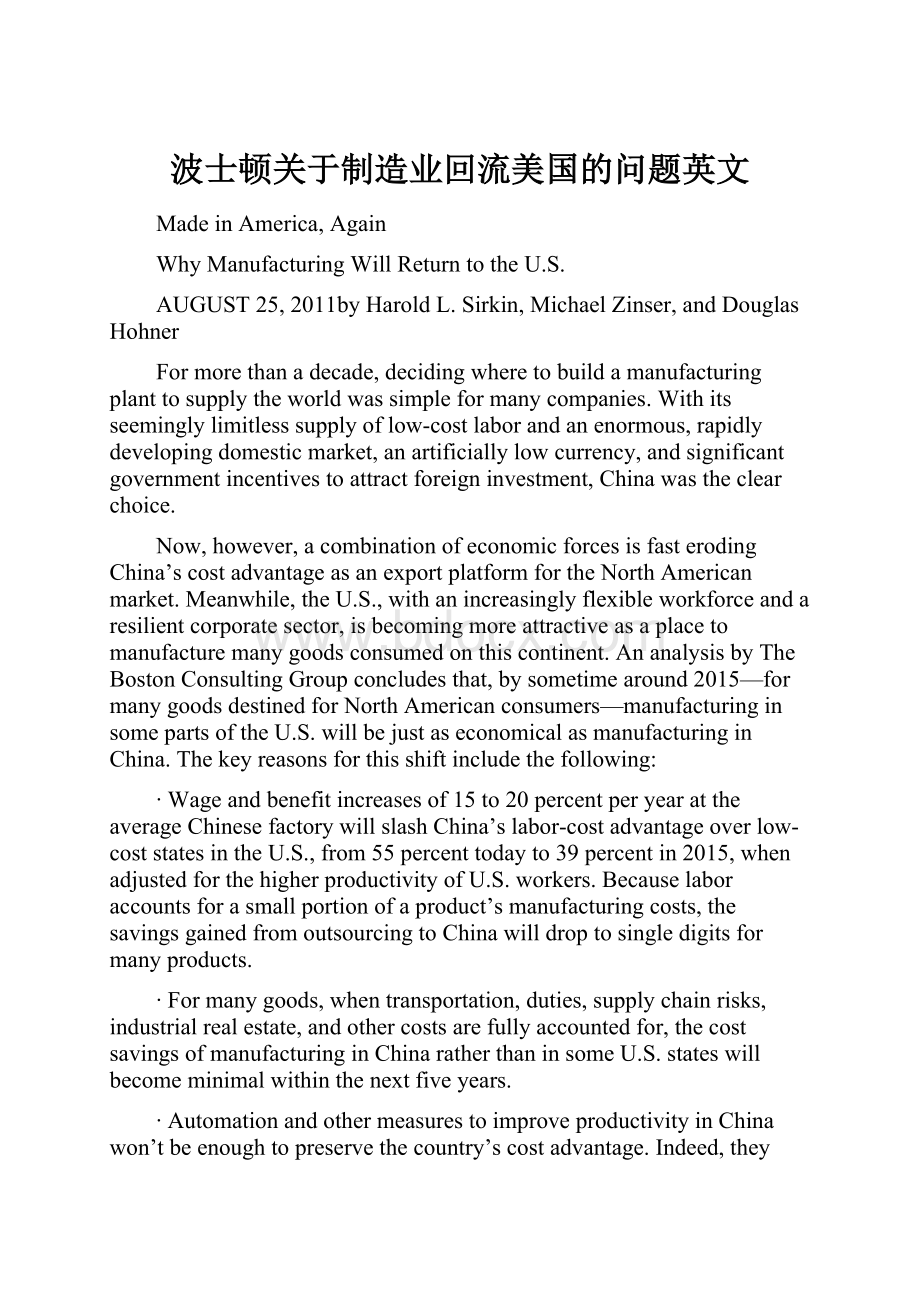波士顿关于制造业回流美国的问题英文.docx
《波士顿关于制造业回流美国的问题英文.docx》由会员分享,可在线阅读,更多相关《波士顿关于制造业回流美国的问题英文.docx(15页珍藏版)》请在冰豆网上搜索。

波士顿关于制造业回流美国的问题英文
MadeinAmerica,Again
WhyManufacturingWillReturntotheU.S.
AUGUST25,2011by HaroldL.Sirkin, MichaelZinser,and DouglasHohner
Formorethanadecade,decidingwheretobuildamanufacturingplanttosupplytheworldwassimpleformanycompanies.Withitsseeminglylimitlesssupplyoflow-costlaborandanenormous,rapidlydevelopingdomesticmarket,anartificiallylowcurrency,andsignificantgovernmentincentivestoattractforeigninvestment,Chinawastheclearchoice.
Now,however,acombinationofeconomicforcesisfasterodingChina’scostadvantageasanexportplatformfortheNorthAmericanmarket.Meanwhile,theU.S.,withanincreasinglyflexibleworkforceandaresilientcorporatesector,isbecomingmoreattractiveasaplacetomanufacturemanygoodsconsumedonthiscontinent.AnanalysisbyTheBostonConsultingGroupconcludesthat,bysometimearound2015—formanygoodsdestinedforNorthAmericanconsumers—manufacturinginsomepartsoftheU.S.willbejustaseconomicalasmanufacturinginChina.Thekeyreasonsforthisshiftincludethefollowing:
∙Wageandbenefitincreasesof15to20percentperyearattheaverageChinesefactorywillslashChina’slabor-costadvantageoverlow-coststatesintheU.S.,from55percenttodayto39percentin2015,whenadjustedforthehigherproductivityofU.S.workers.Becauselaboraccountsforasmallportionofaproduct’smanufacturingcosts,thesavingsgainedfromoutsourcingtoChinawilldroptosingledigitsformanyproducts.
∙Formanygoods,whentransportation,duties,supplychainrisks,industrialrealestate,andothercostsarefullyaccountedfor,thecostsavingsofmanufacturinginChinaratherthaninsomeU.S.stateswillbecomeminimalwithinthenextfiveyears.
∙AutomationandothermeasurestoimproveproductivityinChinawon’tbeenoughtopreservethecountry’scostadvantage.Indeed,theywillundercuttheprimaryattractionofoutsourcingtoChina—accesstolow-costlabor.
∙GivenrisingincomelevelsinChinaandtherestofdevelopingAsia,demandforgoodsintheregionwillincreaserapidly.MultinationalcompaniesarelikelytodevotemoreoftheircapacityinChinatoservingthedomesticChineseaswellasthelargerAsianmarket,andtobringsomeproductionworkfortheNorthAmericanmarketbacktotheU.S.
∙ManufacturingofsomegoodswillshiftfromChinatonationswithlowerlaborcosts,suchasVietnam,Indonesia,andMexico.Butthesenations’abilitytoabsorbthehigher-endmanufacturingthatwouldotherwisegotoChinawillbelimitedbyinadequateinfrastructure,skilledworkers,scale,anddomesticsupplynetworks,aswellasbypoliticalandintellectual-propertyrisks.Lowworkerproductivity,corruption,andtherisktopersonalsafetyareaddedconcernsinsomecountries.
Thisreallocationofglobalmanufacturingisinitsveryearlyphases.Itwillvarydramaticallyfromindustrytoindustry,dependingonlaborcontent,transportationcosts,China’scompetitivestrengths,andthestrategicneedsofindividualcompanies.Butwebelievethatitwillbecomemorepronouncedoverthenextfiveyears,especiallyascompaniesfacedecisionsaboutwheretoaddfuturecapacity.WhileChinawillremainanimportantmanufacturingplatformforAsiaandEurope,theU.S.willbecomeincreasinglyattractivefortheproductionofmanygoodssoldtoconsumersinNorthAmerica.
Thisreport,thefirstinaseries,examinestheeconomictrendsthatpointtoaU.S.manufacturingrenaissance.Italsoexploresthestrategicimplicationsoftheshiftingcostequationforcompaniesengagedinglobalsourcing.
∙TheU.S.“Decline”andRenaissanceinPerspective
∙ThedeathofAmericanmanufacturinghasbeenforetoldmanytimesinthepastfourdecades.AstheonlymajorindustrializednationnotleveledbyWorldWarII,theU.S.accountedforaround40percentoftheworld’smanufacturedgoodsintheearly1950s.Butthen,fueledbyarelentlesswaveofimportsfromareconstructedEuropeandeventuallyfromJapan,theU.S.experiencedadramaticlossofmarketshareinindustriessuchascolorTVs,steel,cars,andcomputerchips.Inthe1970sand1980s,fearsofthelossofU.S.industrialcompetitivenesswereparticularlyacute,promptingawidespreaddebateoverwhetherthenationshouldadopta“JapanInc.”-styleindustrialpolicyandteachitsschoolchildrentospeakJapanese.ThencametheriseofsuchEastAsianTigersasSouthKoreaandTaiwan,whichledtoamassivetransferofproductionoflabor-intensivegoods,includingapparel,shoes,andtoys,andthenofmuchoftheU.S.computerandconsumer-electronicsmanufacturingindustry.
∙TheU.S.sufferedthroughmanypainfuladjustmentstothesechallenges.Unlikemostnations,however,itquicklyrippedofftheBand-Aidandallowedindustrytoadapt.Factoriesclosed,companiesfailed,bankswroteofflosses,andworkershadtolearnnewskills.ButU.S.industryandtheeconomyrespondedwithsurprisingflexibilityandspeedtoreemergemorecompetitiveandproductivethanever.Bythelate1990s,Americancompaniesdominatedtheworldinhigh-valueindustriessuchasmicroprocessors,aerospace,networkingequipment,software,andpharmaceuticals.Manufacturinginvestment,output,andemploymentsurged.
∙Itmaynotbeobviousyet,buttheU.S.manufacturingsectoristodayinthemidstofasimilarprocessofreadjustmentinresponsetoperhapsitsgreatestcompetitivethreatever—theriseofChina.Sinceopeningitsdoorstoforeigninvestmentandtrade,Chinahasofferedavirtuallyunbeatablecombinationofseeminglylimitlesscheaplabor(lessthan$1perhour),agrowingpoolofengineers,afixedcurrency,andlocalgovernmentswillingtoofferinexpensiveland,freeinfrastructure,andgenerousfinancialincentives.
∙InthedecadesinceitenteredtheWorldTradeOrganization(WTO)in2001,Chinahasessentiallybecomethedefaultoptionforcompanieswishingtooutsourceproductioninordertolowercosts.From2000to2009,China’sexportsleaptnearlyfivefold,to$1.2trillion,anditsshareofglobalexportsrosefrom3.9percentto9.7percent,accordingtoUnitedNationsConferenceonTradeandDevelopmentdata.Thesedevelopmentsoccurredinaremarkablebreadthofindustries,fromlabor-intensiveassemblyworktoheavyindustryandhigh-tech.China’sportionofglobalapparelexportsincreasedfrom17.4percentto32.1percent,forexample.Itsshareoftheworldexportmarketforfurnituresoaredfrom7.5percentto25.9percent,forshipsfrom4.1percentto19.6percent,fortelecomequipmentfrom6.5percentto27.8percent,andforofficemachinesandcomputerequipmentfrom4.9percentto32.6percent.IntheU.S.,meanwhile,thelossofsome6millionmanufacturingjobsandtheclosureoftensofthousandsoffactoriesoverthepastdecadehasfannedfrequentwarningsofamanufacturingcrisis.
TheTideIsTurning
Onceagain,however,predictionsofthedemiseofAmericanmanufacturingarelikelytoprovewrong.TheU.S.manufacturingsectorremainsrobust.Outputisalmosttwoandahalftimesits1972levelinconstantdollars,eventhoughemploymenthasdroppedby33percent.DespitetherecentwaveofoutsourcingtoChina,thevalueofU.S.manufacturingoutput increased byone-third,to$1.65trillion,from1997to2008—beforetheonsetoftherecession—thankstothestrongestproductivitygrowthintheindustrialworld.AlthoughChinaaccountedfor19.8percentofglobalmanufacturingvalueaddedin2010,theU.S.stillaccountedfor19.4percent—asharethathasdeclinedonlyslightlyoverthepastthreedecades.
TheconditionsarecoalescingforanotherU.S.resurgence.Risingwages,shippingcosts,andlandprices—combinedwithastrengtheningrenminbi—arerapidlyerodingChina’scostadvantages.TheU.S.,meanwhile,isbecomingalower-costcountry.Wageshavedeclinedorarerisingonlymoderately.Thedollarisweakening.Theworkforceisbecomingincreasinglyflexible.Productivitygrowthcontinues.
Ouranalysisconcludesthat,withinfiveyears,thetotalcostofproductionformanyproductswillbeonlyabout10to15percentlessinChinesecoastalcitiesthaninsomepartsoftheU.S.wherefactoriesarelikelytobebuilt.Factorinshipping,inventorycosts,andotherconsiderations,and—formanygoodsdestinedfortheNorthAmericanmarket—thecostgapbetweensourcinginChinaandmanufacturingintheU.S.willbeminimal.Insomecases,companieswillmoveworktoinlandChinatofindlowerwages.Butthiswillnotbeanattractiveoptioninmanyindustries.Chinesecitiesintheinteriorprovinceslacktheabundanceofskilledworkers,supplynetworks,andefficienttransportationinfrastructureofthosealongthecoast,offsettingmuchofthesavingsaffordedbyslightlylowerlaborcosts.
Whenallcostsaretakenintoaccount,certainU.S.states,suchasSouthCarolina,Alabama,andTennessee,willturnouttobeamongtheleastexpensiveproductionsitesintheindustrializedworld.Asaresult,weexpectcompaniestobeginbuildingmorecapacityintheU.S.tosupplyNorthAmerica.Theearlyevidenceofsuchashiftismounting.
∙NCRmovedproductionofitsATMstoaplantinColumbus,Georgia,thatwillemploy870peopleby2014.
∙TheColemanCompanyismovingproductionofits16-quartwheeledplasticcoolerfromChinatoWichita,Kansas,owingtorisingChinesemanufacturingandshippingcosts.
∙FordMotorCompanyisbringingupto2,000jobsbacktotheU.S.inthewakeofafavorableagreementwiththeUnitedAutoWorkersthatallowsthecompanytohirenewworkersat$14perhour.
∙SleekAudiohasmovedproductionofitshigh-endheadphonesfromChinesesupplierstoitsplantinManateeCounty,Florida.
∙PeerlessIndustr